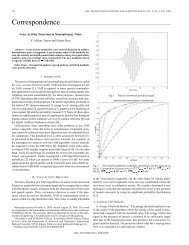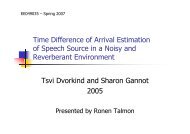Thesis (PDF) - Signal & Image Processing Lab
Thesis (PDF) - Signal & Image Processing Lab
Thesis (PDF) - Signal & Image Processing Lab
You also want an ePaper? Increase the reach of your titles
YUMPU automatically turns print PDFs into web optimized ePapers that Google loves.
6.4. APPLICATION EXAMPLES 105<br />
6.4.3 Initial step for dust and scratch removal<br />
Another example uses opening by reconstruction as an initial step for an application<br />
that removes dust and scratches from images. The elements that remain after filtering<br />
by the opening by reconstruction are completely preserved, including their edges. The<br />
elements that are removed by the opening by reconstruction are completely removed,<br />
including their edges. This feature enables one to catch candidates for dust and<br />
scratch during the initial step. The output of the initial step is a top-hat (TH) filter<br />
that includes all details that were filtered out by opening by reconstruction (OR)<br />
from the original image Ioriginal, and is given by: T H = Ioriginal − OR(Ioriginal). Later<br />
steps of the application can make further analysis of that image in order to decide<br />
which object is dust or scratch and which is not. Afterward, objects that are dust or<br />
scratch, according to decision rule, are removed from the image.<br />
We have compared different methods for this application. The comparison was<br />
done using the energy level of the top-hat image and qualitative evaluation of the<br />
extent of dust and scratch removal. As the energy level of the top hat image is lower,<br />
and as the dust and scratch removal is better, so the filter is declared to be more<br />
efficient. The energy is defined by equation (6.5).<br />
�<br />
�<br />
Enrg = �f�2 = f(i, j) 2 (6.5)<br />
i,j∈f<br />
Where f is the image and Enrg is the image energy level.<br />
We used averaging and median filters for comparison. Table 6.2 summarizes the<br />
energy levels of the top-hat images. Figures from 6.39 until 6.42 show top-hat images<br />
for different structuring elements and image magnifications. The objects in the top-<br />
hat images are the potential candidates for dust and scratch for the later steps of the<br />
application.<br />
For all structuring elements, the averaging filter catches all the edges of the image.<br />
In addition, the energy of the top-hat image is higher for the averaging filter than<br />
for the other filters listed in Table 6.2. This means that the averaging filter catches<br />
too many candidates for dust and scratch. Therefore, it is less suitable for dust and<br />
scratch removal application, than the other compared filters.<br />
For a given image, the energy is higher for the median than for the filter based
















